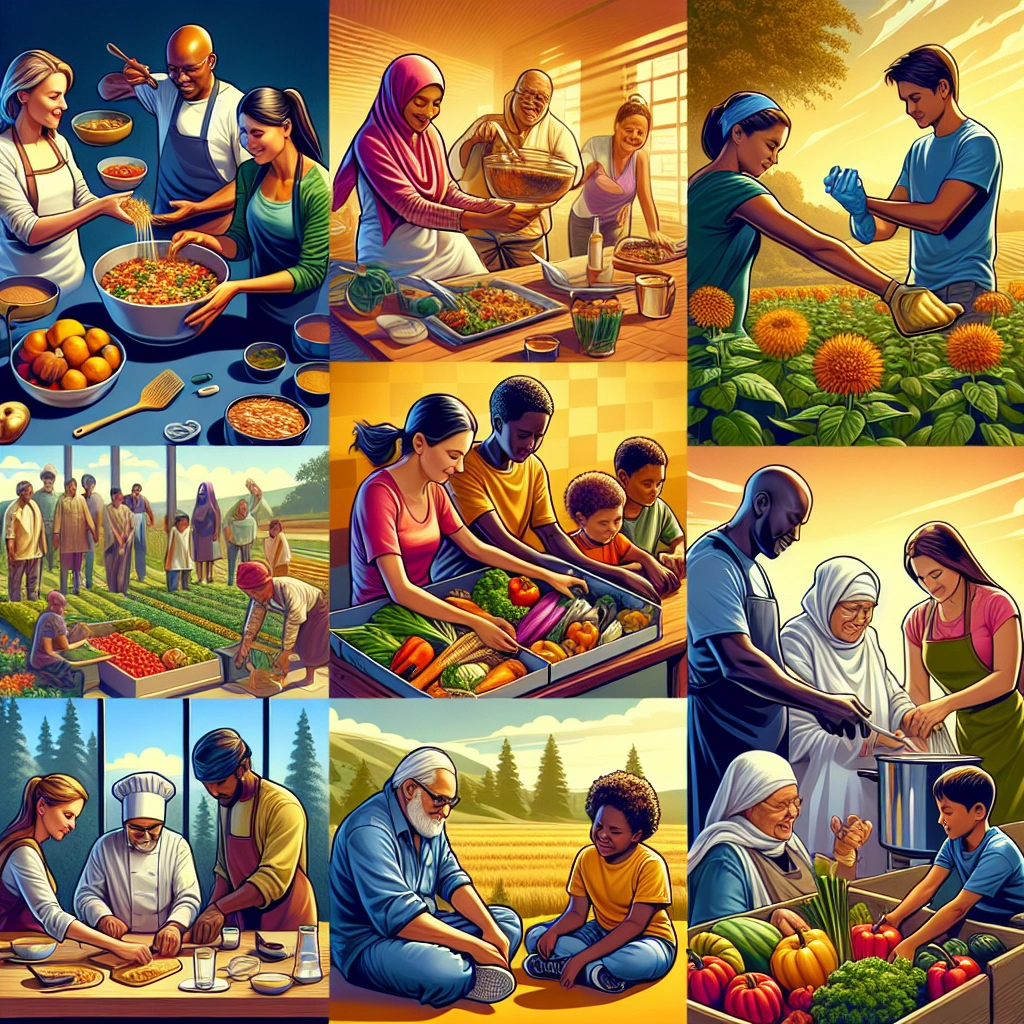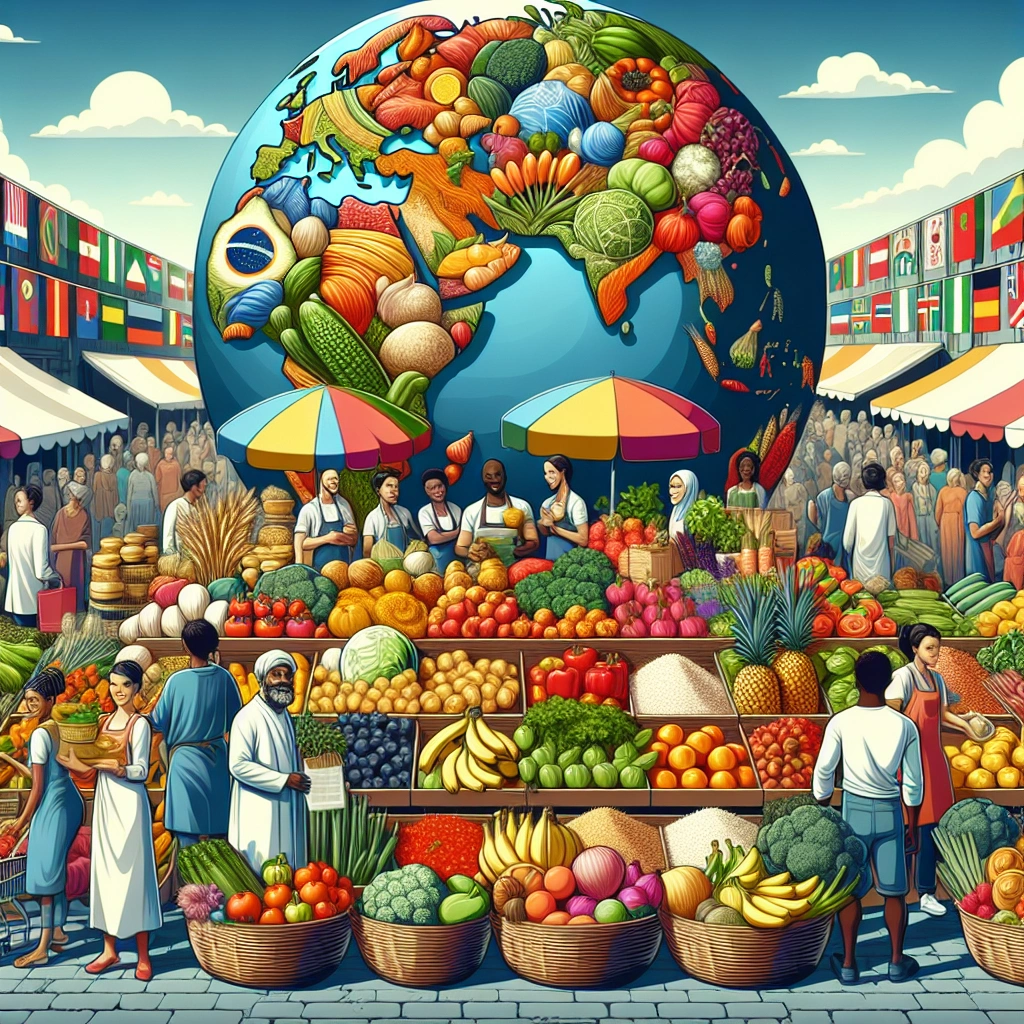

Global food insecurity statistics refers to the data and figures that illustrate the prevalence of inadequate access to food at a global level. It encompasses the percentage of the population facing hunger and malnutrition, as well as the severity of food insecurity across different regions of the world.
Understanding global food insecurity statistics is crucial in addressing the challenges of hunger, poverty, and health disparities on a global scale.
The importance of understanding global food insecurity statistics lies in its ability to inform policy-making, resource allocation, and intervention strategies to combat hunger and malnutrition. By analyzing and interpreting these statistics, governments, organizations, and communities can develop targeted solutions to improve food access, promote economic growth, and create sustainable food systems.
Furthermore, awareness of global food insecurity statistics raises public consciousness and galvanizes collective action to address the root causes of food insecurity.
As the global population continues to grow, the impact of food insecurity becomes more pronounced, making it imperative to monitor and assess global food insecurity statistics. By understanding the prevalence and trends of food insecurity, stakeholders can work towards achieving the goal of food security for all, ensuring that every person has access to safe, nutritious, and sufficient food to lead a healthy and active life.
Consequently, global food insecurity statistics serve as a vital tool in the fight against hunger and the pursuit of a more equitable and sustainable world.
Check out this Youtube video: “State of Food Security and Nutrition in the World 2022” for an eye-opening look at global food insecurity statistics and the current state of food security around the world.
The Impact of Global Food Insecurity Statistics
Health implications of food insecurity
Food insecurity has been linked to a myriad of health implications, including an increased risk for obesity and higher rates of chronic disease in low-income individuals. Research has found that food insecurity is associated with an elevated risk of various chronic health conditions such as diabetes, heart disease, mental health disorders, and other chronic diseases.
Additionally, food insecurity is associated with increased risks of birth defects, anemia, lower nutrient intakes, and cognitive problems, thus highlighting its significant impact on public health.
Economic consequences of food insecurity
The economic consequences of food insecurity are substantial, with an annual cost estimated at $130.5 billion due to illness costs linked to hunger and food insecurity. Moreover, food insecurity has been linked to low wages, adverse social and economic conditions, limited access to healthy foods, and residential segregation, which can lead to productivity loss and hinder overall economic growth.
The continuing prevalence of global hunger is bad for business, inhibiting productivity and slowing economic progress.
Social and political effects of food insecurity
The social and political effects of food insecurity are multifaceted, encompassing implications for public health, political stability, and social inclusion. Food insecurity can lead to social exclusion, unequal access to rights and resources, and long-term implications for political instability.
Furthermore, governments are increasingly concerned about the potential impact of food insecurity on population growth, rapid urbanization, and food availability, which may have profound political and social ramifications. This can be seen in the government’s efforts to combat food insecurity through programs like SNAP, WIC, and NSLP in the United States.
| Economic Consequences | Health Implications | Social and Political Effects |
|---|---|---|
| $130.5 billion – illness costs | Increased risk for obesity | Social exclusion and unequal access |
| Low wages and limited access to healthy foods | Higher rates of chronic disease | Potential impact on political stability |
| Inhibits productivity and slows economic progress | Risks of birth defects and anemia | Concerns regarding population growth and urbanization |
Global food insecurity statistics have far-reaching implications for public health, economic stability, and social welfare, highlighting the pressing need for comprehensive strategies to address this critical issue on a global scale.
Factors Contributing to Global Food Insecurity Statistics
Climate change and its impact on food production
Climate change significantly impacts food production through extreme weather events like heatwaves, droughts, floods, and wildfires. These conditions reduce crop yields, affect livestock, and disrupt agricultural workers.
For example, severe warming and flooding can diminish yields. In some cases, open trading systems mitigate food shortages in certain areas through increased production elsewhere.
Climate change poses a substantial threat to global food security by affecting agricultural output and food supply.
Economic inequality and access to food
Economic inequality directly influences access to food, depending on the distribution of populations, natural resources, and agricultural productivity. This inequality can be further shaped by patterns of agricultural development, international trade, and dietary choices.
For instance, access to healthy, affordable food plays a crucial role in reducing economic disparities and promoting equality of capabilities across different socio-economic groups. Addressing this inequality is essential to ensuring global food security for all individuals.
Conflict and food insecurity
Conflict contributes to food shortages and economic disruptions, endangering the survival of entire populations. Wars often trigger the displacement of large numbers of people, cutting them off from food supplies and livelihoods.
In conflict-affected areas, agricultural activities are disrupted, communities are displaced, and infrastructure is destroyed, perpetuating food insecurity. Consequently, conflict, alongside climate change and economic disparities, plays a critical role in driving food insecurity on a global scale.
Understanding the Data
Sources of global food insecurity statistics
The sources of global food insecurity statistics are varied and include reputable organizations such as the World Bank, the United Nations, and the Food and Agriculture Organization (FAO). These organizations conduct extensive research, gathering and analyzing data from countries across the world to provide comprehensive and reliable statistics on food insecurity.
Additionally, government agencies, academic institutions, and non-governmental organizations (NGOs) contribute to the collection and dissemination of global food insecurity statistics. This collaborative effort ensures that the data is diverse and thoroughly evaluated, providing a holistic understanding of food insecurity on a global scale.
Challenges in collecting accurate data
Collecting accurate data on global food insecurity faces numerous challenges, including political instability, limited access to remote regions, and inadequate infrastructure. Moreover, economic disparities, cultural differences, and varying levels of technological advancement contribute to the complexity of data collection.
Additionally, ensuring the consistency and reliability of the data across different regions and countries poses a significant challenge. These obstacles necessitate the implementation of advanced data collection methodologies and the establishment of strong partnerships with local communities to address the complexities of accurately capturing global food insecurity statistics.
Regional variations in food insecurity statistics
Regional variations in food insecurity statistics are influenced by diverse factors such as climate, economic conditions, and geopolitical instability. For instance, areas prone to natural disasters and extreme weather events often experience heightened food insecurity.
Similarly, regions facing economic challenges, civil unrest, or conflict may exhibit increased levels of food insecurity. Furthermore, cultural practices, dietary preferences, and agricultural capabilities contribute to distinctive patterns of food insecurity across different regions.
These variations underscore the importance of tailored interventions and policies to address the specific needs of each region and combat food insecurity effectively.
| Region | Average Food Insecurity Rate | Notable Characteristics |
|---|---|---|
| South | High | Elevated rates of food insecurity |
| Northeast | Low | Limited variation in food insecurity rates |
The table above illustrates the regional disparities in food insecurity rates, highlighting the substantial differences between the South and Northeast regions in the United States. These variations underscore the need for targeted interventions to alleviate regional discrepancies in food insecurity statistics.
Trends in Global Food Insecurity Statistics
Historical context of food insecurity
In the 20th and early 21st centuries, rates of undernourishment experienced a significant decline, with the UN FAO estimating that hunger affected one-in-three people in developing countries in 1970. However, the rates plummeted to 12% by 2015.
Recent changes in food insecurity statistics
In the previous decade, food insecurity surged, with the percentage increasing from 10.7% to a more substantial figure, reflecting a concerning trend in global food insecurity.
Projected future trends in global food insecurity
The future food insecurity projections indicate unprecedented challenges due to a combination of factors such as conflict, economic shocks, climate extremes, and soaring fertilizer prices. The mid-2023 update shows 238 million individuals across 48 countries facing acute food and nutrition crises, creating an enormous scale of global hunger and malnutrition.
Moreover, the World Bank’s response to this escalating crisis focuses on supporting production and producers, facilitating increased trade in food and production inputs, supporting vulnerable households, and investing in sustainable food security.
| Food Insecurity Statistics | Figures |
|---|---|
| Undernourishment rates in 1970 | One-in-three people in developing countries |
| Undernourishment rates in 2015 | 12% |
| Recent increase in food insecurity | From 10.7% to a higher percentage |
| Projected future trends | Unprecedented challenges due to conflict, economic shocks, climate extremes, and soaring fertilizer prices |
| Global crisis scale | 238 million individuals across 48 countries facing acute food and nutrition crises |
| World Bank’s response | Supporting production and producers, facilitating increased trade in food and production inputs, supporting vulnerable households, and investing in sustainable food security |
Let’s make food security great again!
Addressing Global Food Insecurity
Current initiatives and programs
The World Food Programme (WFP) is tirelessly working to provide food assistance to over 80 million people in 80 countries, striving to respond to emergencies promptly. Additionally, the U. S. Government has launched the Global Food Security Strategy 2022-2026, representing a comprehensive whole-of-government approach to eradicate global hunger, poverty, and malnutrition.
These initiatives showcase a concerted effort to address food insecurity on a global scale.
Policy recommendations to combat food insecurity
To combat food insecurity, it is imperative to implement policies that embrace compassion, create opportunities, consider essential needs, and promote knowledge and empathy. Furthermore, ethical imperatives call for policies that aim to ensure justice in the design and implementation of food security programs.
The policies should focus on achieving the objective of food security without resorting to protectionist trade measures, highlighting the ethical considerations in addressing food insecurity.
The role of individuals in addressing food insecurity
Individuals play a critical role in addressing food insecurity, and community responses are pivotal. Community food security advocates emphasize the importance of viewing food as a right for both individuals and communities rather than as a mere commodity.
Additionally, the Supplemental Nutrition Assistance Program (SNAP) significantly impacts food insecurity by providing nutritional assistance to millions of participants. The community’s involvement and support, coupled with government programs, are essential in combating food insecurity on both local and national levels.
| Initiatives and Programs | Policy Recommendations | Role of Individuals |
|---|---|---|
| World Food Programme | Policies emphasizing compassion and justice | Community food security advocacy |
| U. S. Government Strategy | Ethical imperatives for food security policies | Community involvement and SNAP |
Addressing global food insecurity requires collaborative efforts through initiatives and policies, along with active participation from individuals and communities. These comprehensive measures and considerations are pivotal in tackling the issue on a global scale.
Implications for the Future
Food insecurity has profound long-term consequences on public health, leading to increased susceptibility to infectious diseases, chronic conditions like heart disease and hypertension, and mental health issues such as depression and anxiety disorders. This poses a significant burden on healthcare systems and the overall well-being of individuals, highlighting the urgency to address food insecurity.
Long-term consequences of food insecurity
The sustained impact of food insecurity on individuals’ health and well-being cannot be overstated. Poor nutrition resulting from food insecurity leads to an increased prevalence of diet-sensitive chronic diseases, including diabetes and cardiovascular conditions.
This not only affects individual health but also places greater strain on healthcare resources and services.
Strategies for sustainable food security
To ensure sustainable food security, efforts must focus on reducing food waste, promoting efficient production techniques, and enhancing infrastructure. Embracing plant-based diets and limiting food losses are pivotal steps in achieving long-term food security and nutrition.
By addressing these factors, we can work towards creating a more stable and sustainable food system globally.
The global impact of addressing food insecurity
Addressing food insecurity on a global scale is imperative, especially as the world’s population is projected to reach 9.3 billion by 2050. Embracing a whole-of-government approach, such as the U. S. Government’s Global Food Security Strategy, can significantly contribute to ending hunger, poverty, and malnutrition. Additionally, investing in sustainable food security measures will not only drive economic growth and job creation but also foster positive impacts on human existence and well-being.
| Benefits of Addressing Food Insecurity |
|---|
| Economic Growth and Job Creation |
| Human Existence and Well-being |
| Ending Hunger, Poverty, and Malnutrition |
Recommended Amazon Products for Addressing Global Food Insecurity
Here’s a curated list of products that can help you address global food insecurity with ease. These recommendations are based on affordability, functionality, and positive customer reviews.
Rice Cooker
A rice cooker can be a valuable tool in addressing global food insecurity, as rice is a staple food for many individuals affected by food insecurity. Having a reliable rice cooker can help in efficiently preparing this essential food item. Check out the Rice Cooker on Amazon for a convenient and affordable option.


Multivitamin Supplements
In regions affected by food insecurity, access to a variety of nutritious foods may be limited. Multivitamin supplements can help fill the nutritional gaps and support overall health. Consider trying the Multivitamin Supplements available on Amazon for an added boost of essential nutrients.


Solar-Powered Flashlight
In areas with limited access to electricity, a solar-powered flashlight can be an invaluable resource for individuals facing food insecurity. It provides a reliable source of light for cooking, studying, and other essential activities. Discover the Solar-Powered Flashlight options on Amazon for sustainable and long-lasting lighting solutions.


Portable Water Filtration System
Access to clean water is a critical component of addressing food insecurity. A portable water filtration system can help individuals in affected regions purify water from various sources, ensuring safe drinking water. Explore the Portable Water Filtration System choices on Amazon for convenient and effective water purification.


NutriBullet Blender
A NutriBullet blender can be an excellent addition for individuals facing food insecurity, allowing them to create nutritious and easily digestible smoothies and soups using readily available ingredients. Utilize the NutriBullet Blender available on Amazon to support healthy food options in affected communities.


Top Recommended Product for Addressing Global Food Insecurity
If you’re looking for the best solution to help address global food insecurity, we highly recommend the Portable Water Filtration System. Here’s why:


| Pros | Cons |
|---|---|
| Provides clean and safe drinking water | May require occasional filter changes |
| Portable and easy to use | Initial investment cost |
| Suitable for various water sources | Requires access to natural light for charging |
Ready to make a positive impact on global food insecurity? Check out the Portable Water Filtration System today for the best results!


Conclusion
The global food insecurity statistics reveal a troubling reality of widespread hunger and malnutrition. These statistics highlight the urgent need for action to address the root causes of food insecurity, such as poverty, conflict, and climate change.
Without effective interventions, the impact of food insecurity will continue to have devastating consequences for millions of individuals and communities around the world.
Moreover, the global food insecurity statistics underscore the importance of sustainable and equitable food systems to ensure access to nutritious food for all. Efforts to improve agricultural productivity, promote small-scale farming, and reduce food waste are crucial in combating food insecurity and achieving food security for the entire global population.
It is clear that a comprehensive and coordinated approach is necessary to address the complex challenges posed by food insecurity.
Furthermore, the global food insecurity statistics emphasize the need for international cooperation and solidarity in addressing this critical issue. By working together, governments, organizations, and individuals can make significant strides in reducing food insecurity and ensuring the right to an adequate standard of living for everyone.
It is imperative that efforts to tackle food insecurity are prioritized and supported at the global level to create a more sustainable and food-secure future for all.








